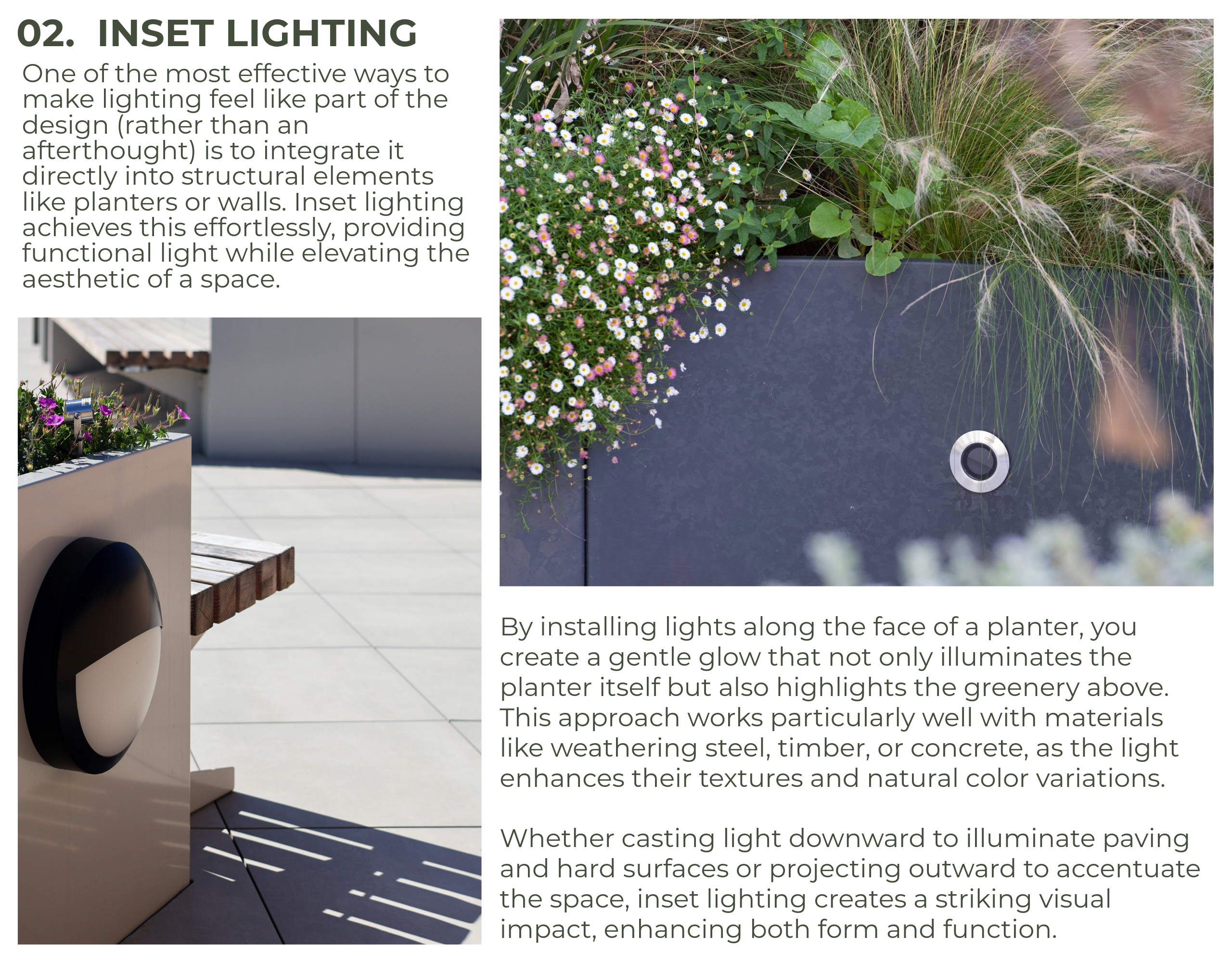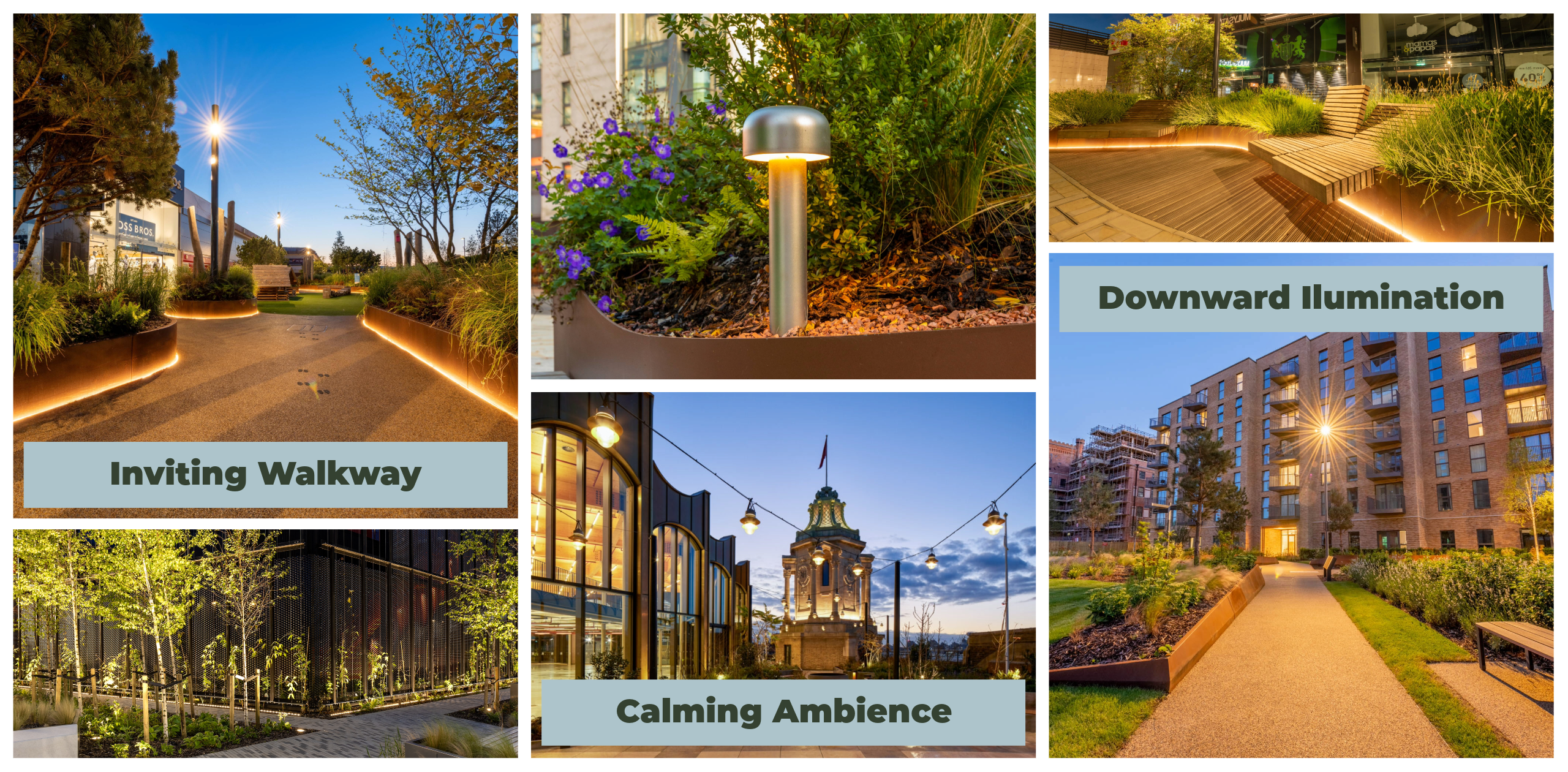In landscape design, lighting plays a vital role, not only in making spaces usable after dark but also in creating atmosphere, guiding movement, and highlighting design details. Thoughtful lighting can add drama, warmth, and elegance, allowing designers to turn even modest spaces into something extraordinary.
Here, we explore creative ways to use lighting to enhance outdoor spaces and inspire designers to think beyond basic fixtures and standard installations.
1. Define Space with Layered Lighting
Layered lighting is the foundation of impactful lighting design. By combining different types of lights—ambient, task, and accent lighting—you create depth and guide the viewer’s eye through the space.
- Ambient Lighting: Soft, diffuse lights that set the mood of the entire space. Consider indirect lighting, such as concealed lights on walls or soffits, to provide a gentle glow without overwhelming the space.
- Task Lighting: Useful for functional spaces, like pathways or outdoor dining areas. Low, direct lighting along walkways not only ensures safety but also adds an inviting warmth that feels intentional.
- Accent Lighting: This is where creativity comes in. Use accent lights to spotlight specific features, like a planter, sculpture, or architectural element, to draw the viewer’s attention to the highlights of your design.

3. Embrace Low-Level Lighting for a Soft, Grounded Look
Rather than spotlighting everything from above, low-level lighting can create a soft, grounded ambience that feels intimate and inviting. This type of lighting is ideal for terraces, courtyards, and garden paths, where the goal is to provide gentle illumination without overpowering the space.
- Pathway Lighting: Discreetly installed lights along paths and stairs add an element of sophistication and safety. Low-level lights along pathways create soft, downward-facing beams that emphasize the beauty of the ground cover and plants along the path.
- Embedded Step Lights: Integrate lights into the face of steps or risers to cast a gentle, horizontal glow along each step, highlighting the architectural flow of the space.
4. Use Uplighting to Add Height and Drama to Vertical Elements
Uplighting is a technique that brings vertical elements to life, making structures appear taller and more impactful. It’s especially useful in creating depth, allowing designers to enhance specific elements without over-lighting the entire space.
- Tree Uplighting: Aim low-profile lights upward along tree trunks or canopy edges to create dramatic silhouettes. This technique is ideal for adding nighttime interest to a roof terrace or courtyard where larger trees or tall planters are central to the design.
- Architectural Features: Uplight structural elements, like pergola posts or large planters, to add depth to your design. Uplighting pairs well with textured materials, such as stone or Corten steel, where the light brings out details and shadows that create visual interest.

5. Use Backlighting for Subtle Depth and Definition
Backlighting is perfect for adding a touch of mystery and elegance, especially in spaces where minimalism and simplicity are key. By illuminating objects from behind, you create an ethereal glow that suggests form without overwhelming it.
- Feature Walls: Install lights behind vertical slats or lattice walls to create a soft, diffused glow that makes the wall appear to float. This works well in private roof terrace designs or secluded garden areas where you want a subtle, magical touch.
- Planting Beds and Shrubs: Place low-profile lights behind planting beds to create silhouettes of plants and foliage. This technique adds depth to the landscape, making the plants feel layered and adding texture to the space.
6. Use Color and Temperature for Atmosphere
The colour and temperature of your lighting can dramatically impact the ambience of outdoor space. By experimenting with warm, cool, and even coloured lights, you can evoke different moods and cater to different occasions.
- Warm Lighting for Intimacy: Choose warm-toned lights (2,700K to 3,000K) to create a cosy, inviting atmosphere ideal for dining or lounge areas. Warm lights work particularly well in natural settings with wood and greenery.
- Cool Lighting for Modernity: Cool lights (4,000K and above) lend a sleek, modern look, perfect for contemporary settings with metallic or stone elements. This is especially effective in highlighting a planter’s clean lines or Corten steel’s industrial appeal.
- Coloured Lighting for Flexibility: RGB lighting offers flexibility for multipurpose spaces, allowing you to shift from a relaxed ambience to a vibrant mood with ease. This option works well in rooftop or terrace designs where users may want to tailor the environment for events or personal enjoyment.
Conclusion: Building Impact with Light
Lighting can transform a landscape by adding drama, enhancing functionality, and guiding how a space is experienced after dark. By using techniques like inset lighting on planters, layering pathways with soft light, and highlighting natural features, designers can create an atmosphere that’s both practical and enchanting.
With these lighting approaches, landscape architects can build a roof terrace or outdoor environment that not only meets practical needs but leaves a lasting, impactful impression.
Back to the Knowledge Base


